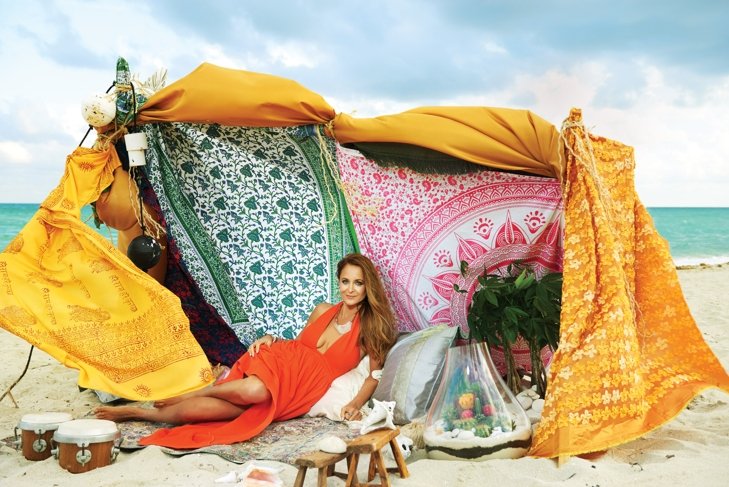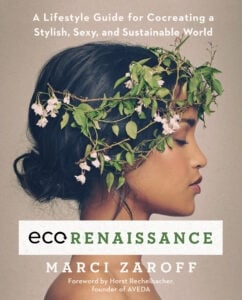
Marci Zaroff wants to change the world. It’s a lofty goal, but as a perpetual green innovator and status-quo disrupter across multiple industries, Zaroff is well on her way to making it happen. You could say she wrote the book on eco-conscious living—and in fact, she has: ECOrenaissance: A Lifestyle Guide for Co-creating a Stylish, Sexy, and Sustainable World.
In an era where natural disasters and other environmental problems dominate the news cycle, more people are starting to think about their footprint. Zaroff believes the ECOrenaissance, a global lifestyle movement centered on sustainability and green culture, is the catalyst to spark a new level of conscious consumption—one that will transform our world for the better.
“Business as usual isn’t working anymore,” Zaroff says. “We need to redesign a different reality.”
A Renaissance for the modern age
Five pillars make up the ECOrenaissance’s DNA: creativity, connection, collaboration, community and consciousness. Together, the five Cs become a roadmap for living a more holistic existence. Zaroff’s book focuses on six key areas in which the five Cs can be applied: art, food, wellness, beauty, fashion and business.
“From food to beauty to fashion, lifestyle is not a single category,” Zaroff says. “We live at the intersection of popular culture, and conscious consumers have choices in all of these sectors.”
But even with increased awareness and more green options than ever before, many consumers avoid selecting eco-friendly alternatives. Zaroff pinpoints three stigmas that keep people from choosing sustainable products. Fortunately, the ECOrenaissance has a response to all three.
1. “I have to give something up.”
Many people still think they must give up taste for healthy food or stylishness for sustainable fashion. Zaroff says that the movement is all about “no compromise” and that products are “this and that.” Plant-based food, for example, is both sustainable and delicious.
2. “I have to pay a lot more.”
While this may have been true at the start of the sustainability movement, when innovations and consumer demand were scarce, the ECOrenaissance is defined by a more efficient supply chain.
3. “How do I know this is really eco-friendly?”
In the past, any company looking to tap into the green consumer market could slap a “sustainable” label on its products and call it a day. Thankfully, third-party certification programs have gone after predatory advertising, giving people renewed confidence.
It’s clear Zaroff has heard all the objections—and can easily rebut them. How did she get to such an enlightened place?
Zaroff’s eco-journey
When Zaroff coined the term “ECOfashion” in 1995, she was in the trenches of the organic and natural foods industry. She was learning a lot about agriculture and farming—and one crop that people often overlook: cotton. This prompted Zaroff to think about the connection between food and fibers.
“I was advocating for organic agriculture and sustainability in food, but what about fashion?” she says. “As I unveiled the human and environmental impacts, the onion layers started to peel back. That was the catalyst for marrying ecology and fashion.”
After her Under the Canopy lifestyle brand was born, featuring sustainable apparel and textiles for homes, hotels, spas and more, Zaroff never looked back (see “Defining an eco-era”). She continues to innovate in new and interesting ways, all with a focus on sustainability. Her latest game-changer, RESET, is a regenerative farming program that marries food and textiles by growing lentils and cotton together.
“Products are always vehicles for the larger story,” she explains. “For the ECOrenaissance, it’s all about going from source to story. I think about how to get to the root of the product. Then I build up the food chain, instead of having to work from the top down.”
Our shared eco-future
While Zaroff was immersed in the sustainability movement from the beginning, she says anyone can be a part of the ECOrenaissance. Technology has made participating a whole lot easier.
“The internet completely changed the game,” she says. “Anyone can go online now and read where things come from. There’s so much more transparency. The movement is about getting more and voting with your dollars. People are waking up.”
Many people are also embracing their inner innovator. At BeyondBrands, the consulting agency and incubator Zaroff created with her husband, Eric Schnell, the two are seeing a serious uptick in the number of social entrepreneurs.
“People used to roll their eyes at sustainable fashion,” Zaroff says. “Now, people value purpose and transparency in new ways. They don’t want to work for a company they don’t believe in.”
Defining an eco-era
Marci Zaroff is a serious serial ecopreneur. Here’s a handy timeline of her many innovations.
- 1990: Zaroff co-founded a health and environmental education center, now called The Institute for Integrative Nutrition—the world’s largest professional health coach certification program.
- 1995: Her lifestyle brand, Under the Canopy, was born, with which she pioneered the market for organic, sustainable apparel and home textiles.
- 2012: She became the founder and CEO of MetaWear. The organic, eco-friendly apparel brand was the first “sustainable style” cut-and-sew manufacturer in the world.
- 2014: Zaroff put on an executive producer hat for the short documentary film series Driving Fashion Forward with Amber Valletta.
- 2016: With her husband, Eric Schnell, Zaroff co-created Good Catch Foods (plant-based seafoods) and BeyondBrands (a “conscious consulting collective”).
- 2018: Zaroff’s latest innovation is RESET (Regenerate Environment Society and Economy thru Textiles), the world’s first “zero-budget, vertically integrated regenerative cotton farming project.”
 In ECOrenaissance: A Lifestyle Guide for Cocreating a Stylish, Sexy, and Sustainable World (Enliven/Atria Books, 2018), Marci Zaroff shares practical wisdom learned over years of being an eco-innovator—plus tips from dozens of like-minded visionaries. One hot tip? Cutting down on or eliminating meat and dairy. She writes that “eating one hamburger is the equivalent of showering for two months straight” when it comes to water usage. Whoa!
In ECOrenaissance: A Lifestyle Guide for Cocreating a Stylish, Sexy, and Sustainable World (Enliven/Atria Books, 2018), Marci Zaroff shares practical wisdom learned over years of being an eco-innovator—plus tips from dozens of like-minded visionaries. One hot tip? Cutting down on or eliminating meat and dairy. She writes that “eating one hamburger is the equivalent of showering for two months straight” when it comes to water usage. Whoa!











